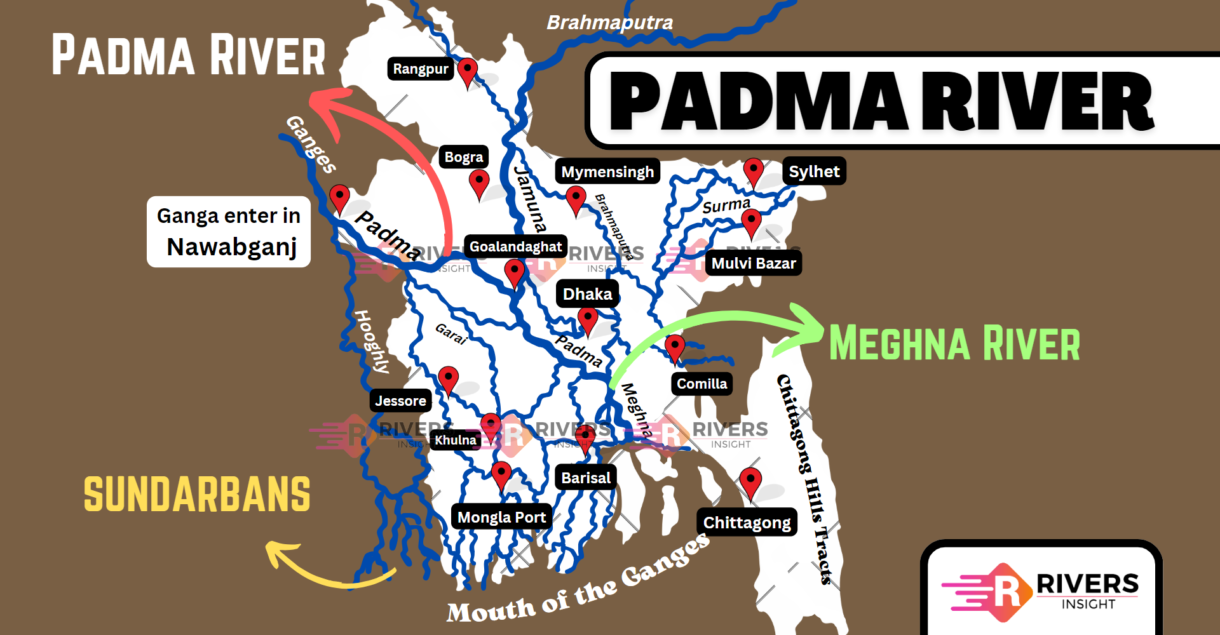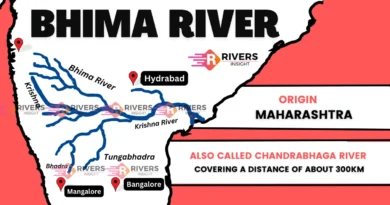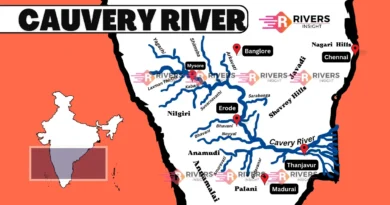Padma River: Along with Map of Bangladesh
The Padma River is one of Bangladesh’s most important rivers, formed by the flow of the Ganges as it enters the country. Stretching over 120 kilometers, it merges with the Jamuna River at Goalandaghat and continues to flow southeast, ultimately joining the Meghna River.
Table of Contents
Geographical Features of Padma River
Origin and Course
The Padma River originates from the Ganges River when it enters Bangladesh at Manakosa and Durlabhpur in the Shibganj Upazila of the Nawabganj district. At this location, the Ganges becomes commonly known as the Padma. Subsequently, the river flows southeastward and merges with the Jamuna River, also called the Brahmaputra in Bangladesh, at Goalandaghat, creating the downstream Padma.
After this confluence, the river continues its journey until it joins the Meghna River near Chandpur and eventually empties into the Bay of Bengal.
The Padma River has a total length of approximately 120 kilometers, varying its width between 4 and 8 kilometers. Furthermore, its course comprises a complex system of distributaries, shoals, and sandbars, which significantly contribute to its dynamic and ever-changing nature.
Tributaries and Distributaries of Padma
Tributaries
- Mahananda River: Joins the Padma near Nawabganj.
- Jamuna River: It contributes to its massive flow at Goalandaghat.
Distributaries
- Madhumati River (Garai in its upper course): Branches off from the Padma and flows southward.
- Faridpur Khal: A small distributary taking off near Tepakhola.
- Arial Khan River: Takes off about 50 km downstream from Goalandaghat.
- Shosha Khal and Naria Khal: Minor distributaries joining the Arial Khan south of Madaripur.
Hydrological and Geological Significance
The Padma River plays a crucial role in shaping the Ganges-Brahmaputra-Meghna Delta, which is the largest delta system in the world. Over centuries, the Ganges has gradually shifted southeastward, establishing its current position in the Bengal Basin and creating a fertile region that supports:
- Extensive agricultural activities
- Dense human settlements
- Rich biodiversity
Flow and Discharge:
- Monsoon Season: The Padma discharges an average of 750,000 cubic meters per second, carrying a substantial sediment load.
- Dry Season: Its discharge reduces significantly to around 15,000 cubic meters per second, with minimal sediment transport.
Braided and Meandering Nature:
Although the Padma is primarily a meandering river, it exhibits a braided character in certain sections. This braided nature arises due to:
- High sediment load
- Shifting and unstable channels
Economic Importance
The Padma River serves as an economic lifeline for Bangladesh, supporting multiple sectors:
- The fertile alluvial soil supports the cultivation of rice, jute, sugarcane, and other crops.
- The river is rich in fish resources, with Hilsa being a major contributor to the fishing industry.
- The Goalandaghat-Chandpur steamer route is a crucial waterway for passenger and cargo transport.
Interesting Facts About the Padma River
- The Ganges-Padma system contributes significantly to forming one of the largest and most fertile deltas in the world.
- The combined flow of the Ganges, Brahmaputra (Jamuna), and Meghna rivers is among the highest in the world, averaging 35,000 cumec.
- During the monsoon, the sediment carried by the Padma plays a crucial role in replenishing the delta’s fertile soil.
So, this is all about the Padma River—its origin, course, tributaries, and distributaries. If you have any questions or would like more information on any aspect of the river, feel free to ask in the comments!




